Introduction to Lighting
When looking at the design of a lighting scheme it is useful to have an understanding on the nature of light itself and some of the basic theory associated with this. This article provides an overview of these concepts.
Nature of Light
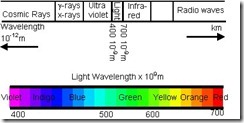 Transitions of electrons from differing shells emit packets of energy (photons). The energy of the photon eV and frequency of emitted radiation v, is related by planks constant h:
Transitions of electrons from differing shells emit packets of energy (photons). The energy of the photon eV and frequency of emitted radiation v, is related by planks constant h:

The wavelength being:

where c is the speed of light.
The eye responds to different wavelength with different efficiencies. Efficiency is highest at wavelengths from 490x10-9 to 510x10-9 m and drops of to either side. Wavelengths below 400x10-9 and above 700x10-9 m cannot be perceived.
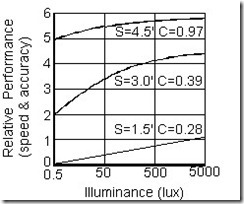 Relative performance of various lighting levels depends on the task sizes(S, minutes) and contrast (C).
Relative performance of various lighting levels depends on the task sizes(S, minutes) and contrast (C).
Contrast is the difference in brightness of the object and it's immediate background:

- LT is the luminance of the task, cd m-2
- LB is the luminance of the background, cd m-2
General increases in contrast improve visual performance. However, beyond a certain limit, vision suffers by becoming visually uncomfortable (discomfort glare) or difficult to see (disability glare).
Theory Introduction
Units and Definitions
- luminous intensity I, candela (cd) - defined as the luminous intensity in the perpendicular direction, of a surface of 1/600000 m2 of a full radiator at the temperature of freezing platinum under a pressure of 101.325 kN m-2
- luminous flux Φ, lumen (lm) - light power emitted per second within a unit solid angle by a uniform point source of (lm = cd sr1).
- Illuminance E, lux - luminous flux reaching a surface perpendicularly per unit area (lux = lm m2)
- luminance L, cd m2 - a measure of light actually emitted per unit projected area of surface, the plane of projection being perpendicular to the direction of view
- luminous efficacy - the efficiency of a lamp is expressed as the ratio of lumens to lamp watts, lm W-1
Illuminance
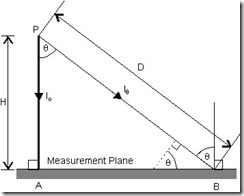 Illuminance consists of two components, the direct Illuminance at a point on a surface and the average Illuminance in a room due to direct flux and reflected flux.
Illuminance consists of two components, the direct Illuminance at a point on a surface and the average Illuminance in a room due to direct flux and reflected flux.
Considering a point source, at point A, we have the inverse square law:

At point B the surface is tilted away from the normal by angle q giving:
 and letting:
and letting: 
we have the cos3 law: 
Small Light Source
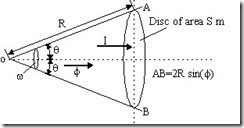 The solid angle ω , is given by:
The solid angle ω , is given by:

The luminous intensity I, is:

The Illuminance of the source is:

The area S, is the projected are as seen from the direction specified.
Large Light Source
Example: A disk source
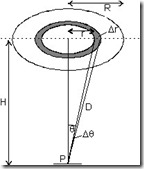 The incremental strip of radius r, width Δr, obeys the inverse square law and all parts are equidistant from P. The strip has an
The incremental strip of radius r, width Δr, obeys the inverse square law and all parts are equidistant from P. The strip has an

If the surface has an Illuminance L (cd m2), the
intensity at P due to the strip is:

and the Illuminance is:

where:


but,
 and as
and as 
 due to the
due to the
incremental strip.
The total Illuminance ET, is:
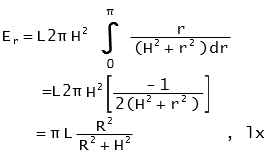
For a source of significant size, to find the Illuminance a small element is considered which obeys the inverse square law and the expression then integrated over the whole surface.
Diagrams & Representation
Luminous intensity I, relates to a specific direction and is specified in three dimensions. For certain Luminaires (e.g. fluorescent), the luminous intensity is different across each lamp axis. The figure illustrates this and shows typical transverse polar and Cartesian representations of intensity.
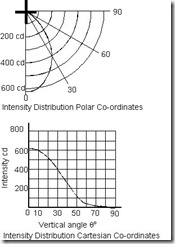
Colour
Mixing of Colour
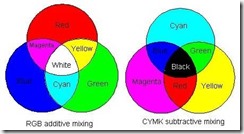

For additive mixing where (R), (G), (B) represent reference stimuli, r, g, b the amounts, a colour C, is expressed as:

and

Specifications of Colour
BS 5252:1976 Framework
| Hue | | 00 - neutral | | 02 - red-purple | | 04 - red | | 06- -warm orange | | 08 - cool orange | | 10 - yellow | | 12 - green yellow | | 14 - green | | 16 - blue-green | | 18 - blue | | 20 - purple-blue | | 22 - violet | | 24 - purple | | | Greyness | | A - grey | | B - near grey | | C - distinct hue | | D - nearly clear | | E - clear, vivid colour | hue -describes the actual colour greyness - represents the clarity weight -refers to lightness Example: Colour 12B29
- dark yellow green |
CEI Colour Rendering Index
| CR | CEI (Ra) | Characteristics | Typical Application |
| 1A | Ra ≥ 90 | excellent colour quality | accurate colour matching required |
| 1B | 80 ≤ Ra < 90 | very good colour quality | accurate colour judgements and/or colour rendering |
| 2 | 60 ≤ Ra < 80 | good colour quality | moderate colour rendering |
| 3 | 40 ≤ Ra < 60 | emphasises yellow and to a lesser extent green, subdues red and to a lesser extent blue | colour rendering not important, marked distortion unacceptable |
| 4 | 20 ≤ Ra < 40 | poor colour quality | colour rendering/matching unimportant |
CR - colour rendering group, CEI - maximum index is 100
NCS Natural Colour System
 One attempt at a colour system which mimics human colour vision is the NCS Natural Colour System. The NCS colour system is able to categorise all surface colours, which each one be identified by a unambiguous notations.
One attempt at a colour system which mimics human colour vision is the NCS Natural Colour System. The NCS colour system is able to categorise all surface colours, which each one be identified by a unambiguous notations.
The system uses six basic colours, white (W), black (S), yellow (Y), red (R), blue (B), and green (G). These elementary colours for the building blocks of what humans can see. NCS descriptions then specify how closely the desired colour resembles the elementary colours.
example: 2030-Y90R
- 2030 is the nuance ( 20% blackness , 30% chromatic-ness)
- Y90R is the resemblance to two elementary colours (yellow with 90% redness)
Munsell Colour System
The Munsell colour-order system is a way of specifying colours using three attributes: hue, value and chroma. Each attribute is given a symbol, H,V, and C and the colour written in as H V/C.
hue - attribute of a colour by which we distinguish red from green, blue from yellow
value - indicates the lightness of a colour
chroma - degree of departure of a colour from the neutral colour of the same value
example: 5R 6/14
- vivid red having a hue of 5R, - value of 6 and chroma of 14